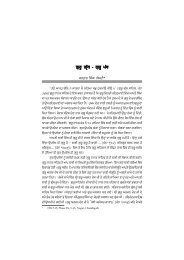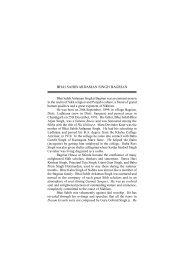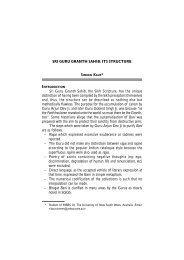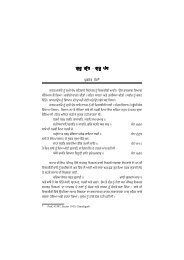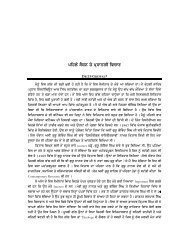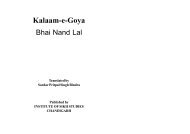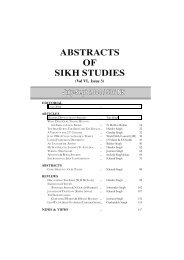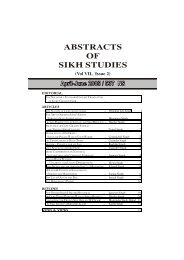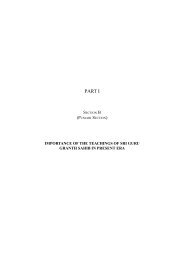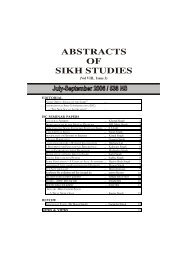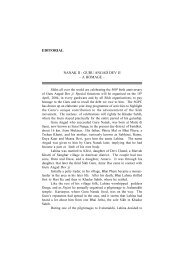Create successful ePaper yourself
Turn your PDF publications into a flip-book with our unique Google optimized e-Paper software.
74ABSTRACTS OF SIKH STUDIES : JAN-MARCH <strong>2006</strong> / 537-38 NSWinning Formula <strong>of</strong> the PUNJ/Consultation used by the Misls.Today the Khalsa Panth faces a similar situation. We are at thelosing end from outside and from within. We need to focus on ourlong-term “needs” and evolve it is very. The Panth is spread out allover the World. Each Diaspora <strong>Sikh</strong> community has its own uniqueset <strong>of</strong> restraints <strong>of</strong> environment/cultural influences/politicalenvironment/economic forces, etc, etc., that has to be dealt with.one Common SOLUTION for all won’t work. Yet we all have certaincore values that we all share with all <strong>Sikh</strong>s all over the world. Wehave to work on the premise that we can agree to disagree on certainpoints. This is the most compelling reason for the establishment <strong>of</strong> anInternational Confederation <strong>of</strong> <strong>Sikh</strong>ism – an Apex Body that hasworldwide representation – so that decisions reached at the Head canbe suitably disseminated at ground zero.Lets have a look at the MISL SYSTEM and how it was so successfulin the late 17 th century and how its validity can be used today for ourbenefit.KHALSA CONFEDERATION – AKA THE MISL SYSTEMThe Misl System can be rightly called the Golden Age <strong>of</strong> <strong>Sikh</strong>ism(if we include the time up to the Khalsa Raaj <strong>of</strong> Maharaja RanjitSingh as that was also a part <strong>of</strong> the same ideology).WHY WAS THIS KHALSA CONFEDERATION SO SUCCESSFUL ?The answer lies in the four aspects <strong>of</strong> Khalsa Brotherhood’sideology that were strictly followed. Equality <strong>of</strong> all, Justice for all,Khalsa above all and Gurmatta Principle <strong>of</strong> republican Democracy.1. Equality <strong>of</strong> all Khalsa. In the Misls, although there was aSardar or leader – that was strictly for command structure purposes –in effect all were equal. From the foot soldier to the sardar – no onewas more equal than the other. As an example, we can see that whenPunjab Governor <strong>of</strong> the Mughal Govt decided to make peace withthe <strong>Sikh</strong>s and <strong>of</strong>fer them a Jagir and title <strong>of</strong> Nawab to go with it, theKhalsa Forces had a meeting and the post was <strong>of</strong>fered to the StableHand Kapur Singh, who then became Nawab Kapur Singh. In anordinary classification, the title and jagir would have gone to a sardar<strong>of</strong> one <strong>of</strong> the Misls. This was one Underlying Principle <strong>of</strong> faith Guru



